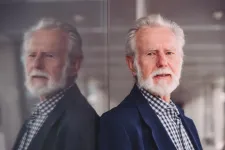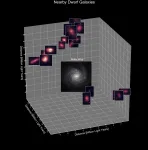(Press-News.org) Among the powerful biochemicals of the human immune system, peptides are one of the best.
Most commonly found in the places where microbes love to take root - mucous membranes of the eye, mouth, nose and lungs - they're known to kill all sorts of tiny invaders, such as viruses, bacteria and fungi.
Given their power, one might think peptides would represent promising drug treatments, perhaps even a cure, for many infectious diseases. But, alas, they are fundamentally flawed: They are vulnerable to a myriad of enzymes whose job is to rapidly break them down in a way that robs them of their therapeutic properties.
"Because of their vulnerability to enzymatic breakdown, peptides are not ideal drugs. They're expensive to produce, and yet they must be given in large doses because they disintegrate so quickly," said Annelise Barron, an associate professor of bioengineering at Stanford School of Engineering.
But, as Barron describes in the journal Pharmaceuticals, she and a team of collaborators have now created peptide-like molecules - which she calls "peptoids" - that could circumvent peptides' shortcomings and turn these new molecules into the basis for an emerging category of antiviral drugs that could treat everything from herpes and COVID-19 to the common cold. Although Barron cautions that years of development and testing remain before these peptoid-based drugs will make it to market, results to date are extremely encouraging.
A better backbone
Peptoids are among a class of biochemicals known as "biomimetics" - molecules that mimic the behavior of biological molecules, but with certain key advantages.
Their real-world counterparts, the peptides, are composed of series of bioactive amino acids, known as side chains, bonded in a specific sequence to a long-chain scaffold, known as the peptide backbone. The result is a little like a biomolecular charm bracelet. Unfortunately, the bonds that hold the all-important charms in place are too easily dissolved in the body by the enzymes known as proteases, which digest proteins. When peptides dissolve, their powers vanish.
Peptoids, however, are engineered for durability. Their strength derives from their structure, which is like, and yet fundamentally different from, that of peptides. By altering the underlying backbone and strengthening the bonds that hold the charms in place, Barron's team has created a way for these antiviral agents to retain the powers that peptides lose when they are degraded by proteases.
"We are excited that our peptoids show great potential as novel antivirals," Barron said.
Upside potential
In their study, Barron and team chose to focus on the herpes virus, which is most notable for causing cold sores around the mouth, sexually transmitted infections and even certain forms of blindness. If contracted later in life, herpes can be particularly devastating to its host. Herpes virus brain infections also are associated with Alzheimer's disease, an active area of research.
The team reviewed a number of prospective peptoids, beginning with a library of 120 molecular structures - which were at that point just chemical symbols on a page. Based on preliminary experiments, they narrowed these to 10 promising candidates, which her team synthesized. Barron then worked with professor Gill Diamond (University of Louisville) to test her newly minted molecules not just for their effectiveness against the herpes virus, but also for their effect on healthy human cells from the exterior surface of the mouth - known as the oral epithelium.
As expected, some of the peptoids showed no effect against the virus. Others were active, but harmful to healthy host cells. But a precious handful of five peptoids proved worthy of additional study. In the end, two hit the sweet spot - defanging the herpes virus while not harming epithelial cells. One of the candidates, in fact, showed "complete" effectiveness against the virus, and that has Barron excited about the possibilities for treating herpes and, perhaps, beyond.
Bursting the bubble
The peptoids work by disrupting the virus's encapsulating outer membrane. This protective bubble is key to any virus's ability to insinuate itself into healthy tissues and distribute its harmful DNA into human cells, leading to infection.
"Peptoids destroy the membranes, not just of herpes but other viruses as well. This should give them wide applicability, perhaps even against certain deadly viral infections that currently have no cure," Barron said.
Barron has since sent samples of peptoids to infectious disease labs around the world asking them to test these new structures against a host of virulent strains, most notably the SARS-CoV-2 virus that causes COVID-19, but also more familiar viruses like influenza and rhinovirus, the culprit behind the common cold.
"The early reports from my collaborators are very encouraging," Barron said. "Because our peptoids mimic a very specific human broad-spectrum antiviral peptide - cathelicidin LL-37 - we weren't surprised that they work, but still absolutely delighted to see these results coming in from all around the world."
INFORMATION:
A clinical study led by Linköping University and financed by pharmaceuticals company Diamyd Medical has investigated whether immunotherapy against type 1 diabetes can preserve the body's own production of insulin. The results suggest that injection of a protein, GAD, into lymph nodes can be effective in a subgroup of individuals. The results have been published in Diabetes Care.
In type 1 diabetes, the body's immune system attacks the cells that produce insulin. When the insulin-producing cells have disappeared, the body can no longer regulate blood sugar level, and a person with type 1 diabetes must take exogenous ...
Regular, standardized assessments of evacuation shelters can help keep people healthy following natural disasters, according to research published by Tohoku University scientists and colleagues in the journal Heliyon. The study found that a clean tap water supply and hygienic toilets were especially important for protecting evacuees from the spread of infectious diseases.
"A clean water supply and maintaining hygiene are important for reducing environmental health risks among victims of natural disasters," says Tadashi Ishii, who specializes in disaster medicine at Tohoku University. "But scientists have
not yet established a strong evidence base that describes the relationship between damage in resource supplies and infrastructure ...
HOUSTON - (May 24, 2021) - U.S. and Austrian physicists searching for evidence of quantum criticality in topological materials have found one of the most pristine examples yet observed.
In an open access paper published online in Science Advances, researchers from Rice University, Johns Hopkins University, the Vienna University of Technology (TU Wien) and the National Institute of Standards and Technology (NIST) present the first experimental evidence to suggest that quantum criticality -- a disordered state in which electrons waver between competing states of order -- may give rise to topological phases, "protected" quantum states that are of growing interest ...
A diverse microbial community has adapted to an extremely salty environment deep in the Red Sea. The microbes, many unknown to science, occupy a one-meter-thick area overlying the Suakin Deep, an expansive 80-meter-deep brine lake, 2,771 meters below the central Red Sea. The chemical properties of this thin "brine-seawater interface," along with the composition of microbial communities, change surprisingly rapidly across a sharp gradient.
"Our study sheds light on how microorganisms in the Suakin Deep's brine-seawater interface make an oasis of life in the desert of the deep Red Sea," says microbial ...
Osaka, Japan - Scientists from the Institute of Scientific and Industrial Research, and NTN Next Generation Research Alliance Laboratories at Osaka University developed a machine learning method that combines convolutional neural networks and Bayesian hierarchical modeling to precisely predict the remaining useful life of rolling bearings. This work may lead to new industrial monitoring methods that help manage maintenance schedules and maximize efficiency and safety under defect progression.
A rolling bearing consists of two rings separated by rolling elements (balls or rollers). Because of the ease of rolling, the rings can rotate relative to each other with very little friction. Rolling bearings are essential to almost all automated machinery with rotating elements. The bearings ...
Scientists used to perform experiments by stirring biological and chemical agents into test tubes.
Nowadays, they automate research by using microfluidic chips the size of postage stamps. In these tiny devices, millions of microscopic particles are captured in droplets of water, each droplet serving as the "test tube" for a single experiment. The chip funnels these many droplets, one at a time, through a tiny channel where a laser probes each passing droplet to record thousands of experimental results each second.
These chips are used for such things as testing new antibiotics, screening drug compounds, sequencing the DNA and RNA of single cells, and otherwise speeding up the pace of scientific ...
Three dozen dwarf galaxies far from each other had a simultaneous "baby boom" of new stars, an unexpected discovery that challenges current theories on how galaxies grow and may enhance our understanding of the universe.
Galaxies more than 1 million light-years apart should have completely independent lives in terms of when they give birth to new stars. But galaxies separated by up to 13 million light-years slowed down and then simultaneously accelerated their birth rate of stars, according to a Rutgers-led study published in the Astrophysical Journal.
"It appears that these galaxies are responding to a large-scale ...
Ever since the existence of molecules was proven and molecular reactions were predicted, humans have wanted to visually observe how such events proceed. Such observations of single-molecule reactions are highly important for the fundamental understanding of chemical sciences, which would aid in the development of novel catalysts, materials, or drugs, and help us decipher the complex biochemical processes. However, this was not possible for the longest time in modern chemistry, and so far the information of dynamical processes on the nanometer scale was obtained only from indirect methods because molecules ...
Healthcare and aerospace experts at King's College London, The Alan Turing Institute, the University of Cambridge, and the Oden Institute for Computational Engineering and Sciences at UT Austin in Texas have said advances in digital twin technology make it a powerful tool for facilitating predictive and precision medicine and enhancing decision-making for aerospace systems. Their opinion piece was published today in Nature Computational Science.
When applied to healthcare, the digital twin, a virtual version of real-life objects that can be used to predict how that object will perform, could predict how a patient's disease will develop and how patients are likely to respond to different therapies.
It is also of huge benefit in aerospace, where, for example, the technology ...
Climate change impacts felt in the Amazon rainforest prior to the arrival of European settlers after 1492 may have meant populations of indigenous people were already in decline before the 'Great Dying', new research has suggested.
Scientists studying fossil pollen and charcoal data from across the Amazon say it appears to show that human management of the rainforest may have peaked around 1200 AD, before some sites were abandoned, allowing reforestation of these areas.
The new research, involving University of Reading scientists and published in the journal Science, challenges the prior assumption that the largest population decrease in the Americas - known as the Great Dying - did not start until after European settlers carried new diseases to ...





